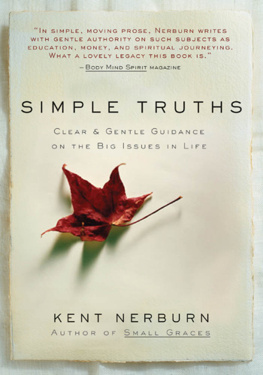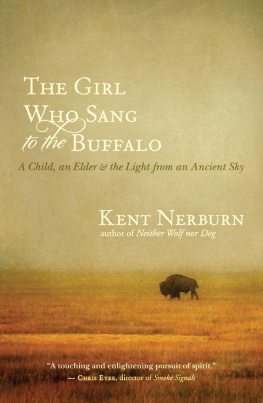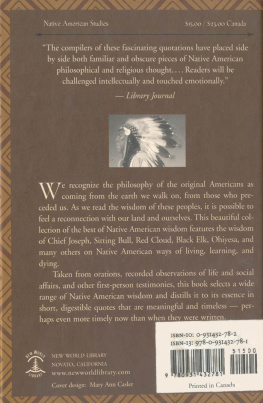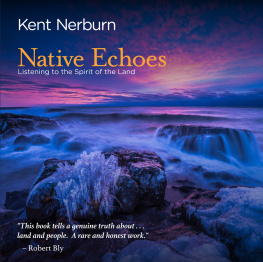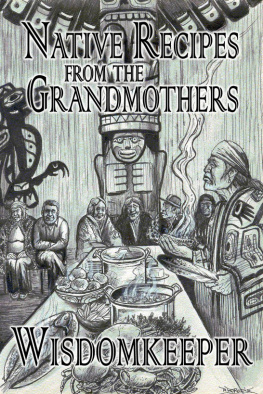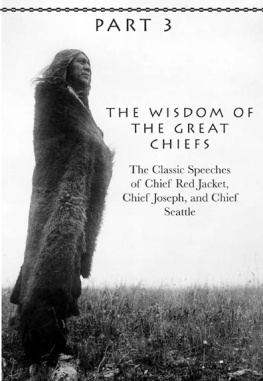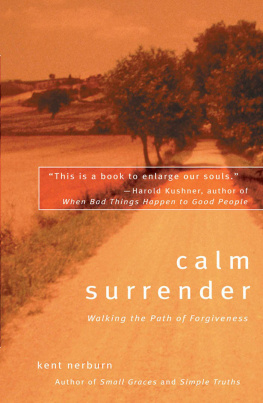Praise for Neither Wolf nor Dog
A chronicle extraordinary for its difficult truths and its stunning depths...This is a sobering, humbling, cleansing, loving book, one that every American should read.
Yoga Journal
This is one of those rare works that once youve read it, you can never look at the world, or at people, the same way again. It is quiet and forceful and powerful.
American Indian College Fund
Praise for The Wolf at Twilight
Emotionally arresting...Nerburn shines when describing the humor and heartbreak he finds on South Dakotas Pine Ridge Indian Reservation....Heartfelt wisdom is found throughout Dans quest for closure and the tale is beautifully told.
Publishers Weekly
After my prison cell began to cool from the days heat, I opened Kent Nerburns creative and compassionate book, which I found humorous, hilarious, and at times very sad. Thank you, Kent, for a good book to read. Doksha.
Leonard Peltier, author, artist, and activist
Elegant, yet powerful...Nerburn crosses borders with a single-minded dedication to preserving an oral tradition. The emotional truth that resides in the rich storytelling is a testament to the strength and endurance of Lakota culture and...removes barriers to understanding our common humanity.
Winona LaDuke, founder and executive director
of the White Earth Land Recovery Project
The story of this unique and captivating journey should be accepted with an open heart. It is a remarkable gift that we are honored to receive and obligated to pass on.
Steven R. Heape, Cherokee Nation citizen
and producer of the award-winning documentary
The Trail of Tears: Cherokee Legacy
Offers a sensitive, insightful glimpse into a Lakota soul, a feat unattainable by most non-Native writers.
Joseph Marshall III, author of The Lakota Way
and The Journey of Crazy Horse
Praise for The Girl Who Sang to the Buffalo
Simply riveting. Kent Nerburn has the very rare ability to gently and compassionately teach in a respectful way. I love this book. And so does the rest of our staff.
Susan White, manager of Birchbark Books
How do you live when you dont know what spirits to believe in? The Girl Who Sang to the Buffalo poses this question for Natives and non-Natives alike. In it, a mysterious Native American girl named Yellow Bird from an Indian boarding school shows us what we already know within ourselves about which spirits to follow. With this book, Kent Nerburn leads us on a search through old and new Native America in a touching and enlightening pursuit of spirit.
Chris Eyre, director of Smoke Signals

Also by Kent Nerburn
Calm Surrender
Chief Joseph and the Flight of the Nez Perce
The Girl Who Sang to the Buffalo
A Haunting Reverence
Letters to My Son
Make Me an Instrument of Your Peace
Neither Wolf nor Dog
Ordinary Sacred
Road Angels
Simple Truths
Small Graces
The Wolf at Twilight
Edited by Kent Nerburn
The Wisdom of the Native Americans
The Soul of an Indian
Native American Wisdom


| New World Library 14 Pamaron Way Novato, California 94949 |
Copyright 2016 by Kent Nerburn
All rights reserved. This book may not be reproduced in whole or in part, stored in a retrieval system, or transmitted in any form or by any means electronic, mechanical, or other without written permission from the publisher, except by a reviewer, who may quote brief passages in a review.
Some names and identifying characteristics have been changed to protect individuals privacy.
Library of Congress Cataloging-in-Publication Data is available.
First printing, December 2016
ISBN 978-1-60868-390-1
Ebook ISBN 978-1-60868-391-8
Printed in Canada

| New World Library is proud to be a Gold Certified Environmentally Responsible Publisher. Publisher certification awarded by Green Press Initiative. www.greenpressinitiative.org |
10 9 8 7 6 5 4 3 2 1
Quietly, for Raymond

Do not begrudge the white man
his presence on this land.
Though he doesnt know it yet,
he has come here to learn from us.
A SHOSHONE ELDER

CONTENTS
TO MOST OF US, Native America is an unknown world shrouded in myth and misconception. To the extent we think of it at all, we imagine a world of drunks, welfare cheats, and casino millionaires or, conversely, elders possessed of deep, mystical earth wisdom.
What we dont see are people who predate us here on this continent and who, in their many ways and many centuries of life here, have evolved a way of understanding and interacting with the land that is at once distinctly different from the Euro-American way and rich with a knowledge of its own.
For almost three decades I have lived and worked among these people. What those years have shown me is that there is something fundamental in the Native way of seeing and living that has much to teach us all. It is something about being human, about living humbly on the earth.
Over the centuries and generations, all cultures develop and refine a particular genius. The genius of the Native peoples has always been to care for and pay deep attention to the relationships of nature.
They do not build, they listen.
They seek harmony, not mastery.
They value connections, not distinctions.
As one elder put it, We are an honoring people, not a discovering people. We look upon life as a mystery to be honored, not a puzzle to be solved.
How far this is from our contemporary way of understanding, where our relentless and insatiable curiosity has allowed us to split the atom, cure disease, and advance the cause of human civilization in unimaginable ways, but has often left us bereft of humility in the face of our human limitations.
In my thirty years of friendship with Native peoples, I have tried to learn the lessons they have to teach. These lessons were often revealed obliquely, couched in metaphor or hidden from direct sight by years of cultural deterioration and transformation. Often, like tiny flowers unfamiliar to the untrained eye, they were hardly visible at all, and as easily overlooked by the outsider as they were taken for granted by those whose lives had been spent in their constant presence.
A mother speaking of her enigmatic son as impossible to understand without looking at the landscape all around him did not see this as a contemporary expression of the Native way of learning by constant observation of the natural world.
A man speaking of a recently deceased relative as having walked on rather than having passed away did not see this as an example of the Native belief in death as part of a continuous journey in contrast to our more Christian idea of death as a disjunctive event that removes the dead from our presence.
Next page


